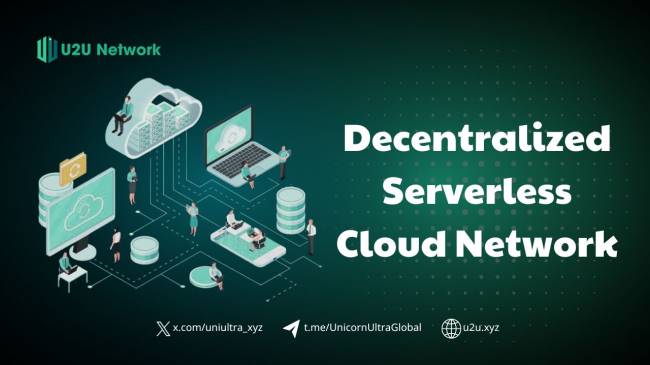In the rapidly evolving technological landscape, traditional cloud computing solutions are increasingly revealing limitations in centralization, cost, and scalability. Enter the Decentralized Serverless Cloud Network, a groundbreaking solution poised to usher in a new era for the cloud computing industry. By merging serverless technology with decentralization, this model not only addresses existing challenges but also unlocks new opportunities for developers and businesses alike. In this article, we will explore the top 10 benefits of a Decentralized Serverless Cloud Network, from cost savings and enhanced security to flexible scalability and censorship resistance.
Table of Contents
Scalability Flexibility
The decentralized serverless cloud network is designed to tackle one of the biggest challenges in blockchain technology: scalability. Thanks to its unique architecture, this network can automatically adjust resources to meet the evolving demands of applications, ensuring stable performance and eliminating bottlenecks.
Automated Resource Adjustment
Flexibility and Efficiency: Operating as an ecosystem, nodes within the network autonomously join or leave based on workload. During periods of high demand, additional nodes are activated to provide extra resources (CPU, memory, bandwidth). Conversely, when demand decreases, unnecessary nodes are deactivated to conserve energy.
Solution to Scalability Issues: Traditional blockchains often face scalability issues during sudden spikes in transaction volume, resulting in slow confirmation times and high transaction fees. The decentralized serverless cloud network addresses this by autonomously scaling to meet demand, ensuring a smooth user experience.
Real-World Applications in DeFi
Uniswap: As a leading decentralized exchange (DEX), Uniswap processes billions of dollars in transactions daily. Leveraging the scalability of the decentralized serverless cloud network, Uniswap efficiently handles this immense transaction volume without compromising speed or transaction fees.
Compound: This decentralized lending and borrowing platform also utilizes scalability to provide fast and efficient financial services to users worldwide.
Benefits for Blockchain Projects
Sustainable Growth: Flexible scalability enables blockchain projects to expand without being limited by technological infrastructure.
Cost Reduction: Usage-based payment models significantly reduce costs compared to maintaining dedicated infrastructure.
Enhanced User Experience: Fast transactions, low fees, and high availability are crucial factors in attracting and retaining users.

Decentralization
The decentralized serverless cloud network inherits and amplifies the power of decentralization, a core principle of blockchain technology. Unlike traditional cloud models that rely on centralized servers, this network operates on a distributed network of independent nodes.
Eliminating Single Points of Failure
- Reduced risk of attack: In centralized systems, attacks on central servers can cause system-wide disruptions. A decentralized network eliminates this vulnerability because there is no single point of control. Even if some nodes are compromised or experience issues, the network continues to function normally with the remaining nodes.
- Enhanced resilience: Decentralization enhances the network's resilience against DDoS attacks and other technical failures. Data and applications are distributed across multiple nodes, ensuring continuous service availability.
Blockchain Integration
- Decentralized consensus mechanisms: Similar to blockchain, the decentralized serverless cloud network uses distributed consensus mechanisms to verify and authenticate transactions or activities on the network. This ensures transparency and security while eliminating the need for trusted intermediaries.
- Community control: In a decentralized network, no single organization or individual has absolute control. Instead, control is distributed among the community of users and participating nodes. This creates a fair and transparent environment where everyone has a voice.
Benefits for Users and Businesses
- Enhanced security: Decentralization minimizes the risk of data loss or theft from attacks or technical failures.
- Transparency and trust: Network operations are recorded on the blockchain, ensuring transparency and verifiability.
- Independence and autonomy: Users and businesses are not reliant on a single service provider, reducing the risk of control or restrictions.
Enhanced Security
The decentralized serverless cloud network not only brings scalability and decentralization but also prioritizes security. Through the combination of advanced encryption technology and distributed data mechanisms, this network establishes a strong protective layer for user and business information.
Encryption and Data Distribution
- End-to-end encryption: Data is encrypted from creation and only decrypted upon reaching its intended recipient. This ensures data confidentiality during transmission, preventing unauthorized access.
- Data sharding: Information is fragmented into multiple pieces and distributed across various nodes. This strategy makes it exceedingly challenging for attackers to compromise or manipulate data, as they would need control over multiple nodes simultaneously.
Zero-Knowledge Proofs (ZKP)
- Verification without disclosure: ZKP allows one party to prove knowledge of information without revealing the information itself. For instance, proving adulthood without disclosing birthdate details.
- Application in the network: ZKP can verify transaction validity or network activities without exposing sensitive user data. This enhances privacy and security across the network.
Benefits of Enhanced Security
- Defense against cyber attacks: The network is resilient against common threats like DDoS attacks, spoofing, and data breaches.
- Protection of sensitive information: Measures such as encryption and ZKP safeguard critical data such as financial records, personal details, and medical information.
- Enhanced trust: High-security standards promote trust among users and businesses, encouraging the development of new applications and services on the network.
.jpg)
Optimal Performance
The decentralized serverless cloud network delivers superior performance, eliminating common speed barriers found in traditional systems. Thanks to its serverless architecture, this network significantly reduces latency, enabling applications to respond faster and providing a smooth user experience.
Eliminating Latency
- Instantaneous startup: Functions activate nearly instantaneously upon request, unlike traditional servers that require startup and shutdown times. This minimizes latency, ensuring responsive applications.
- Resource optimization: Resources are allocated dynamically based on actual demand, ensuring optimal processing power without wastage.
Comparison with Traditional Models
Decentralized serverless cloud networks often outperform centralized cloud models in processing speed. This advantage is critical for real-time applications like online gaming, financial services, and interactive platforms.
Benefits of Performance
Improved user experience: Faster response times enhance user satisfaction and retention.
Enhanced operational efficiency: Swift processing speeds increase productivity and operational efficiency for businesses.
Cost reduction: Resource optimization under the pay-as-you-go model reduces operational costs by eliminating unnecessary investments.
Cost Efficiency
The decentralized serverless cloud network not only delivers superior performance but also helps businesses achieve significant cost savings. The pay-as-you-go model, combined with automatic resource scaling, optimizes operational costs and eliminates unnecessary investments.
Pay-as-You-Go Model
- Pay for what you use: Unlike traditional models where businesses pay for server rental and continuous operation, the serverless cloud network charges based on actual resources used. This means you only pay for the processing time, memory, and bandwidth your application actually needs.
- Flexibility and savings: This model is particularly suited for applications with fluctuating workloads, as you don't pay for excess resources during low-demand periods.
Potential Cost Savings
- Reduced initial investment costs: Businesses do not need to invest in expensive hardware and infrastructure.
- Lower operational costs: Maintenance, upgrades, and server management costs are significantly reduced.
- Energy cost optimization: The serverless model helps reduce energy consumption, contributing to environmental protection and lowering electricity costs.
High Availability
The decentralized serverless cloud network not only delivers superior performance but also helps businesses achieve significant cost savings. The pay-as-you-go model, along with automatic resource allocation, optimizes operational costs and eliminates unnecessary investments.
Usage-Based Payment Model:
- Pay for what you use: Unlike traditional models where businesses pay for server rental and continuous maintenance, the serverless cloud network charges based on actual resource usage. This means you only pay for the processing time, memory, and bandwidth your application actually needs.
- Flexibility and savings: This model is particularly suitable for applications with fluctuating workloads, as you don't have to pay for excess resources during low-demand periods.
Potential Cost Savings:
- Reduced initial investment costs: Businesses no longer need to invest in expensive hardware and infrastructure.
- Lower operating costs: Costs for maintenance, upgrades, and server management are significantly reduced.
- Energy cost optimization: The serverless model helps reduce energy consumption, contributing to environmental protection and reducing electricity costs.
Continuous Innovation
The decentralized serverless cloud network is not just a technological platform but also an open ecosystem that fosters continuous innovation in the blockchain field. Thanks to its flexibility and high integration capability, this network provides favorable conditions for developing new and creative applications, while supporting existing blockchain projects to maximize the potential of the technology.
Flexibility and Integration
- Open architecture: The network is designed with an open architecture, allowing developers to easily integrate various technologies and services into their applications. This creates high flexibility and customization to meet the diverse needs of blockchain projects.
- Support for diverse programming languages: The network supports multiple popular programming languages, enabling developers to build applications on familiar platforms.
- Rich APIs and SDKs: The network offers a variety of application programming interfaces (APIs) and software development kits (SDKs), helping developers save time and effort in the application development process.
Example Blockchain Projects
- Ethereum: As one of the leading blockchain platforms, Ethereum has built a diverse ecosystem of DApps on the decentralized serverless cloud network. These DApps leverage the network's advantages in scalability, security, and decentralization to provide services in finance, gaming, social networks, and various other fields.
- Other projects: Many other blockchain projects are actively developing and deploying applications on this network, creating a vibrant development community and driving innovation in the blockchain field.

Transparency
The decentralized serverless cloud network is not only an advanced technology but also operates as a transparent and reliable system. This transparency is ensured through recording all activities on the blockchain, an immutable distributed ledger technology.
Recorded on Blockchain
- Immutable and tamper-proof: Every transaction, operation, and change in status within the network is recorded on the blockchain. This data is encrypted and distributed across multiple nodes, ensuring immutability and resistance to alteration or deletion.
- Public and verifiable: Anyone can access and verify data on the blockchain. This creates absolute transparency, allowing users and stakeholders to verify the accuracy and validity of all activities on the network.
Community Value
- Building trust: Transparency forms the foundation of trust within the blockchain community. With all activities publicly accessible and verifiable, users can trust in the fairness, honesty, and security of the network.
- Promoting collaboration: Transparency fosters an open and clear environment, encouraging collaboration among community members. People can contribute ideas, propose improvements, and work together to build a better network.
- Enhancing accountability: Transparency enhances the accountability of involved parties within the network. Developers, service providers, and users all have a responsibility to ensure the accuracy and validity of their activities.
Benefits of Transparency:
- Enhanced user trust: Users can confidently use the network, knowing that all activities are recorded and verifiable.
- Attracting investment and partners: Transparency attracts potential investors and partners who value the honesty and reliability of the network.
- Promoting sustainable development: Transparency creates a healthy environment where the community can collaboratively develop and build a strong, sustainable network.
Environmental Friendliness
The decentralized serverless cloud network not only brings technological and economic benefits but also plays a crucial role in environmental protection. By leveraging renewable energy sources and minimizing energy waste, this network demonstrates a strong commitment to sustainable development.
Renewable Energy
- Utilizing clean energy sources: The network prioritizes the use of renewable energy sources such as solar, wind, and hydroelectric power to operate its nodes. This helps reduce carbon emissions and negative environmental impacts.
- Collaboration with green energy providers: The network can collaborate with renewable energy providers to ensure a stable supply of clean energy.
Energy Waste Reduction
- Serverless model: The serverless model minimizes energy waste by using resources only when necessary. Nodes are activated only when processing demands require them and automatically shut down when not needed, avoiding unnecessary energy consumption.
- Optimizing energy efficiency: The network is continuously optimized to improve energy efficiency, employing algorithms and cutting-edge technologies to minimize energy consumption.
Environmental Benefits
- Reducing carbon emissions: Using renewable energy and minimizing energy waste significantly reduces carbon emissions, contributing to climate change mitigation.
- Conserving natural resources: Minimizing energy consumption helps conserve natural resources such as coal, oil, and natural gas.
- Building a green corporate image: Businesses utilizing this network can build an environmentally friendly corporate image, attracting environmentally conscious customers and partners.

The Future of Technology Infrastructure
The decentralized serverless cloud network is not just a burgeoning technological trend but a revolution shaping the future of technology infrastructure. With superior benefits in scalability, security, efficiency, and sustainability, this network promises to change how we build, deploy, and use applications and services across all sectors.
Infinite Potential
- Finance: Decentralized Finance (DeFi) applications leverage this network to create transparent, secure, and efficient financial services.
- Healthcare: The network can securely store and share healthcare data, supporting remote healthcare applications and medical research.
- Education: Online education platforms can utilize the network's scalability and high availability to provide better learning experiences for students.
- Entertainment: Gaming, media, and entertainment applications can utilize the network to create more interactive and engaging experiences.
Development Trends
- Web3: The decentralized serverless cloud network is considered a key pillar of Web3, a new era of decentralized internet where users are in control.
- Internet of Things (IoT): The network's scalability and security will play a crucial role in supporting the development of IoT applications.
- Artificial Intelligence (AI): The network can provide the necessary computational power for AI applications while ensuring data privacy and security.
Challenges and Opportunities
Despite its immense potential, the decentralized serverless cloud network still faces challenges such as establishing common standards, addressing governance issues, and ensuring compatibility with existing systems. However, these challenges also present opportunities for developers, businesses, and the community to collaboratively build a brighter future for technology.
The decentralized serverless cloud network represents not just a significant technological advancement, but a revolutionary approach to technology infrastructure. With its flexible scalability, superior security, optimized performance, and cost-effectiveness, this network has demonstrated immense potential in reshaping the future of cloud computing.
Beyond technical benefits, the decentralized serverless cloud network also emphasizes strong commitments to transparency, continuous innovation, and environmental protection. It operates on an open platform that encourages community engagement and contributions, fostering a sustainable technological ecosystem.
With these outstanding advantages, the decentralized serverless cloud network is not only an attractive choice for businesses and developers but also a promising solution for the future of technology infrastructure. Follow U2U Network to update the latest information about Blockchain





.png)
